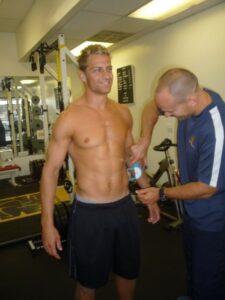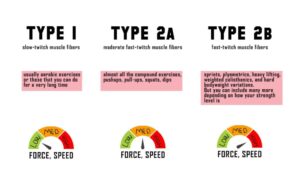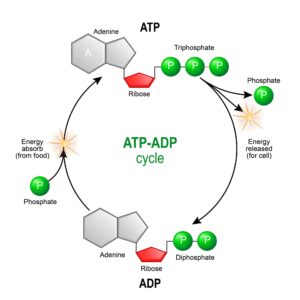If you want to get your ideal body by losing body fat and increasing your lean muscle mass, you will want to know what the acronyms EPOC, ATP & HIIT mean.
Muscle Fiber Type
 To understand EPOC, we need to know a little about muscle fiber type. Everyone has two general types of muscle—slow-twitch and fast-twitch muscle fibers. Although slow-twitch muscle fibers do the majority of the work during slow and moderate aerobic exercise (walk or jogging), fast-twitch muscle fibers are used for shorter, more explosive movements (intense strength training or sprinting).
To understand EPOC, we need to know a little about muscle fiber type. Everyone has two general types of muscle—slow-twitch and fast-twitch muscle fibers. Although slow-twitch muscle fibers do the majority of the work during slow and moderate aerobic exercise (walk or jogging), fast-twitch muscle fibers are used for shorter, more explosive movements (intense strength training or sprinting).

Fast-twitch movements burn significantly more calories than slow-twitch movements. This shouldn’t come as a surprise, as activities like intense strength training and sprinting are much more tiresome than an activity like walking or jogging. Strength training and sprinting also help you burn calories long after your workout has concluded via a process known as EPOC (Excess Post-exercise Oxygen Consumption).
EPOC (Excess Post-exercise Oxygen Consumption)
During very intense exercise like strength training and sprinting, your body actually uses more oxygen than it takes in. When your workout is over, your body has to recover from that stress and needs to use oxygen to do so and this process burns calories.

EPOC (also known as oxygen debt) is similar to taking your car on a long trip and once you get to your destination and turn off the engine, it stays very warm for hours after the trip. The same thing happens to your body after exercise. Similar to how a car’s engine remains warm after being turned off, once a workout is over and you’re back in your daily routine, your body’s metabolism can continue to burn more calories than when at complete rest. EPOC explains how your body can continue to burn calories long after you’ve finished your workout on your quest for your ideal body.
ATP & Exercise
 On a cellular level, your workouts are powered by a chemical compound called adenosine triphosphate (ATP), which is what essentially supplies the energy necessary for metabolism. The more ATP you use for exercise, the more calories you need to help produce more ATP for recovery. The higher the intensity of the exercise, the more ATP energy and oxygen you need after for your body to recover. One of the most efficient workout strategies to increase your exercise intensity is to use HIIT.
On a cellular level, your workouts are powered by a chemical compound called adenosine triphosphate (ATP), which is what essentially supplies the energy necessary for metabolism. The more ATP you use for exercise, the more calories you need to help produce more ATP for recovery. The higher the intensity of the exercise, the more ATP energy and oxygen you need after for your body to recover. One of the most efficient workout strategies to increase your exercise intensity is to use HIIT.
What is HIIT?
 HIIT (High Intensity Interval Training) workouts are composed of short periods of intense work, then a subsequent period of rest or active recovery. To be most effective, clients should be working near or at peak effort during the work intervals. Work-to-rest ratio can be manipulated during HIIT and typically follows these guidelines:
HIIT (High Intensity Interval Training) workouts are composed of short periods of intense work, then a subsequent period of rest or active recovery. To be most effective, clients should be working near or at peak effort during the work intervals. Work-to-rest ratio can be manipulated during HIIT and typically follows these guidelines:
- to improve aerobic fitness – intervals would typically involve a work to rest ratio of 1:1 or 1:2 (work for 30 seconds, rest for 30-60 seconds)
- to train anaerobically (sport-specific training for power and explosiveness) – rest intervals are often longer to allow for a more maximal effort, often at least a 1:5 ratio (work for 15 seconds, rest for 75 seconds).
The major benefits of using HIIT for your workouts are:
- body fat loss
- increased EPOC
- reduced blood sugar, blood pressure and resting heart rate
For your ideal body, HIIT can be added to your strength training workout as a 15-minute circuit or it can comprise the entire 45-minute workout. For most clients, we recommend 1-3 HIIT workouts per week in addition to 2-3 strength training workouts, 1-2 sprint sessions and daily walking exercise.
Whether you are just starting out on your journey for the ideal body, or are a seasoned athlete looking to take your fitness to the next level, Back to Function can help you achieve your goals. Give us a call at 310-534-1900 or email info@backtofunction.com to Feel, Recover & Perform Better Now!
References:
Sprinting Should Be Part of Your Workouts. backtofunction.com
These 14 HIIT Workouts Will Make You Forget Boring Cardio. Men’s Health
Excess Post-exercise Oxygen Consumption. ACE blog
Bersheim, E. and Bahr, R. (2003). Effect of exercise intensity, duration and mode on post-exercise oxygen consumption. Sports Medicine, 33, 14, 1037-1060
LaForgia, J., Withers, R. and Gore, C. (2006). Effects of exercise intensity and duration on the excess post-exercise oxygen consumption. Journal of Sport Sciences, 24, 12, 1247-1264.



